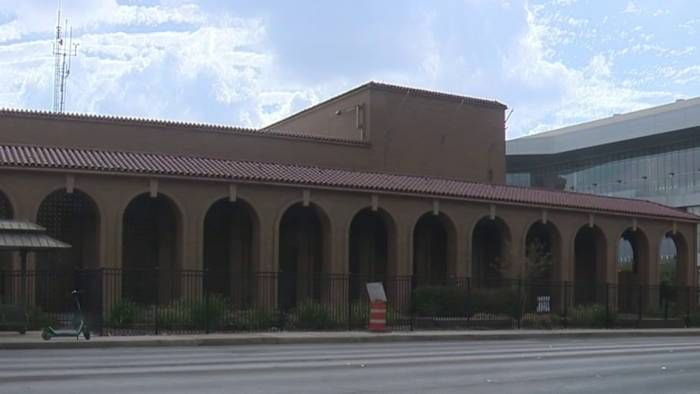SAN ANTONIO – Relocating a chilled water plant in downtown to make room for Project Marvel could cost more than $200 million.
So who would carry that water? The San Antonio Water System says it won’t be its regular customers, who are already facing a rate increase.
Part of the City of San Antonio’s plans for a new sports and entertainment district around Hemisfair call for building another hotel across the street from the Henry B. González Convention Center, which would require relocating an existing SAWS chilled water plant.
The plant on Commerce Street is one of two in the downtown “district cooling system,” which pump cold water to feed the air conditioning systems of 22 downtown sites, including the convention center, the Alamodome, various hotels and La Villita. The utility has a second district cooling system at Port San Antonio.
SAWS has hired an engineering firm to look into the feasibility of moving the Commerce Street plant to another site farther north and expanding it to pump out even more water to handle the development the utility expects will come with the rest of Project Marvel.
Other projects within the district include a new Spurs arena and surrounding mixed-use development, renovating a former federal courthouse into an event venue and expanding the convention center.
Jaime Castillo, SAWS chief of staff and senior vice president of operations support and innovation, said an early relocation cost estimate of $100 million came before the utility knew what the potential growth would be.
At an Oct. 1 city council meeting, Castillo said he was “pretty confident saying it’s not going to be south of $200 million.”
In an interview with KSAT on Thursday, Castillo called both of those numbers “back of the envelope” estimates.
The first “true” cost estimate on the relocation and expansion, he said, will come when the contractor delivers its report, which the utility expects shortly before Thanksgiving.
“It’s not a foregone conclusion that we’re going to move this plant,” Castillo said.
The feasibility study, he said, should help determine how much of the relocation cost could be covered by adding new customers.
“If the feasibility study comes back and says, ‘you know, hey, growth’s going to pay for some of it, but there’s going to be a big gap,’ there’s going to be a serious discussion about whether it’s even feasible to move and build a larger plant.”
In an Oct. 7 SAWS board meeting, Castillo told trustees the utility was looking at a “blend” of funding to pay for the expansion, listing examples like a bond or a tax increment financing zone (TIRZ) — a type of tax capture district that sets aside a portion of property tax revenue for projects in a specific area.
“What we’d like to do is talk to the city about perhaps the TIRZ or the entertainment district or some of that contributing towards — we have 14,000 tons currently at (the Commerce Street plant). We’d like to be made whole for that in this process,” Castillo said.
In his Thursday interview with KSAT, Castillo said a bond would be through the city.
“The critical thing we’re looking for out of this feasibility study is to see if growth can pay for all or a big portion of this expansion and relocation,” Castillo said. “If there is a gap, then it’s a discussion with the city to see what other funding sources there are. And that will be the city’s total discretion to decide whether it’s some of those options we discuss.”
SAWS already plans to propose a rate increase. However, the possible plant relocation doesn’t figure into it.
When asked directly if residential or commercial rate payers would be on the hook for any of it, Castillo said “absolutely not.”
“We’ve gone through great pains and a lot of work here to make the chilled water system a standalone system,” he said. “So water and wastewater and residential customers, commercial customers, they have nothing to do with this. This is a standalone business unit within SAWS that just serves these customers downtown and at Port San Antonio.”
If the utility were to raise the rates on its existing chilled water customers, Castillo said there would have to be a reason, such as changing out their piping.
An emailed statement from a city spokesman also indicated the plant relocation isn’t a done deal.
SAWS is conducting a feasibility study for the relocation and expansion of a chilled water plant. The study will factor in the projected additional growth in customers and load for the new chilled water facility. The goal is that this growth in the chilled water system will pay for the expanded capacity and as much of the relocation costs as feasible. To date, the City has not received a projected cost for relocation of the chilled water plant, projected expansion costs, or projected chilled water rates. If determined to not be feasible, then the relocation will not proceed.
City of San Antonio statement
Bexar County voters will be asked during the Nov. 4 election about another part of Project Marvel: a new Spurs arena. Proposition B will ask voters whether to use a county venue tax to help fund part of the arena’s construction.
Though the arena and hotel are both part of the proposed sports and entertainment district, the city spokesman confirmed they are not directly tied.
SAWS Board Chairwoman Jelynne LeBlanc Jamison also tried to make the difference clear at the Oct. 7 meeting.
“I think, Jaime, it’s important to say that those costs that we’re talking to the city about are not included or a part of the proposed proposition A or B that’s in the community today,” she said.
“Correct. Correct,” Castillo said. “It’s separate and apart from that.”
Read also:
Copyright 2025 by KSAT – All rights reserved.

